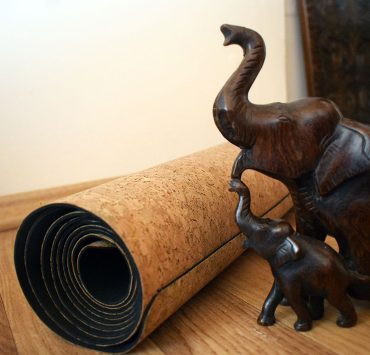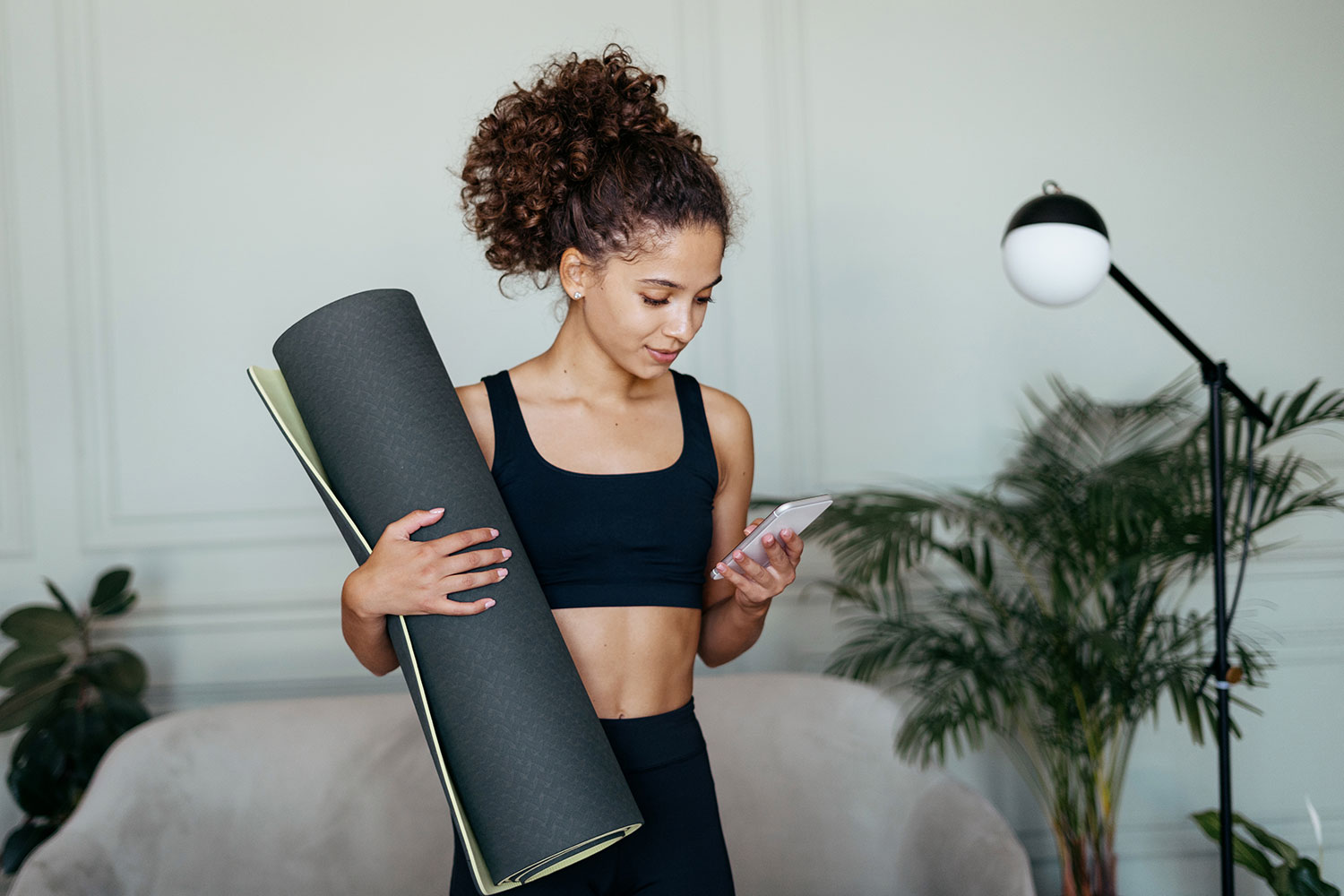
Susan views the world through a lens of spirituality, health,…
Yoga mats are a yogi’s constant companion, but these beloved practice partners can also be breeding grounds for harmful germs and bacteria. While commercial yoga mat cleaners are available at different price points, it’s also quite simple to whip up your own DIY yoga mat sprays.
However, it’s important to remember that not all sprays are created equal, especially when it comes to disinfection and their ability to kill harmful viruses like COVID-19.
Regularly spray down your yoga mat before and after you roll it up. It’s also good to periodically give it a deep clean to ensure it stays clean and safe for you to use daily.
Yoga mat sprays made out of all-natural ingredients can be just as effective as chemical cleaners. Still, they must be used properly and with other maintenance habits to keep mats and other yoga props clean and bacteria-free.
These two recipes are easy to mix up at home and, when used properly, are safe to use around your home and on your skin.
Make sure you source your oils from reputable companies that only sell food or medical grade, organically grown essential oils.
Bacteria and Coronavirus Concerns
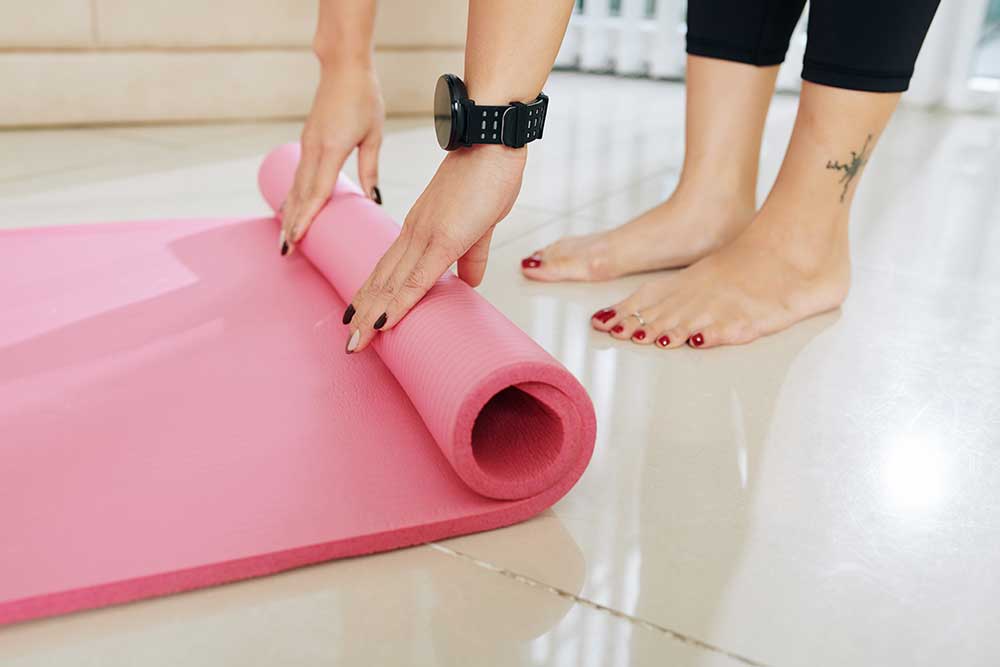
Researchers have shown that yoga mats, especially those shared at yoga studios and gyms, may harbor bacteria like Staphylococcus aureus and pantoea agglomerans, a fecal marker.
In addition to bacteria, fungi can also thrive on moist, unmaintained yoga mats.
In the year 2020, the coronavirus COVID-19 caused most of the world to go into lockdown mode. The virus spreads through direct contact with droplets from sneezing, coughing, or even speaking.
Scientists don’t yet know how long COVID-19 can survive on surfaces, but they hypothesize that it is similar to its cousin, Sars-CoV-2. This version of the coronavirus can survive in droplets in the air for three hours, cardboard for up to 24 hours, and smooth surfaces for up to seven days.
It’s important to bring your own mat to yoga class now that gyms and yoga studios have begun to reopen to help prevent further spread of the virus. And you must be diligent in cleaning your mat for your health and the safety of those around you.
The Effectiveness of Natural Yoga Mat Sprays
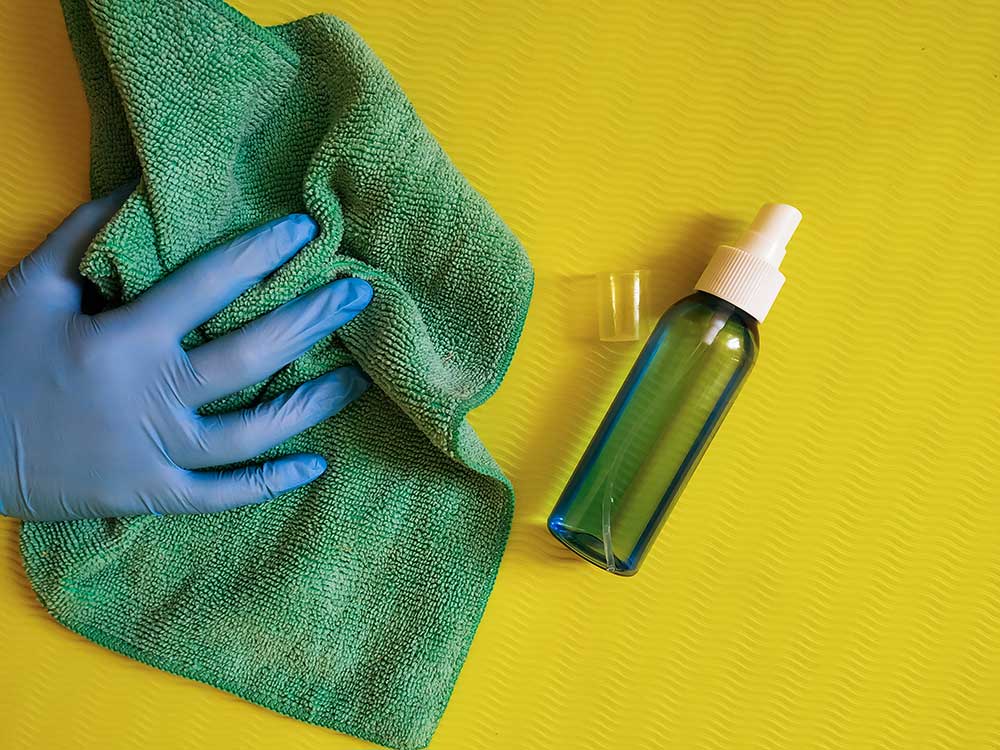
DIY yoga mat sprays made with high-grade essential oils known for their antibacterial, antifungal properties can be just as effective as commercial mat sprays and wipes, which may contain harsh chemicals.
In addition to essential oils, you can also use witch hazel water, which is known to have disinfectant properties to kill microbes.
If you want your all-natural yoga mat spray to contain alcohol, you can use vodka with a minimum of 60-95% alcohol or 180 proof. Anything lower will not meet the minimum recommendation of the CDC.
Top Essential Oils to Disinfect Your Yoga Mat
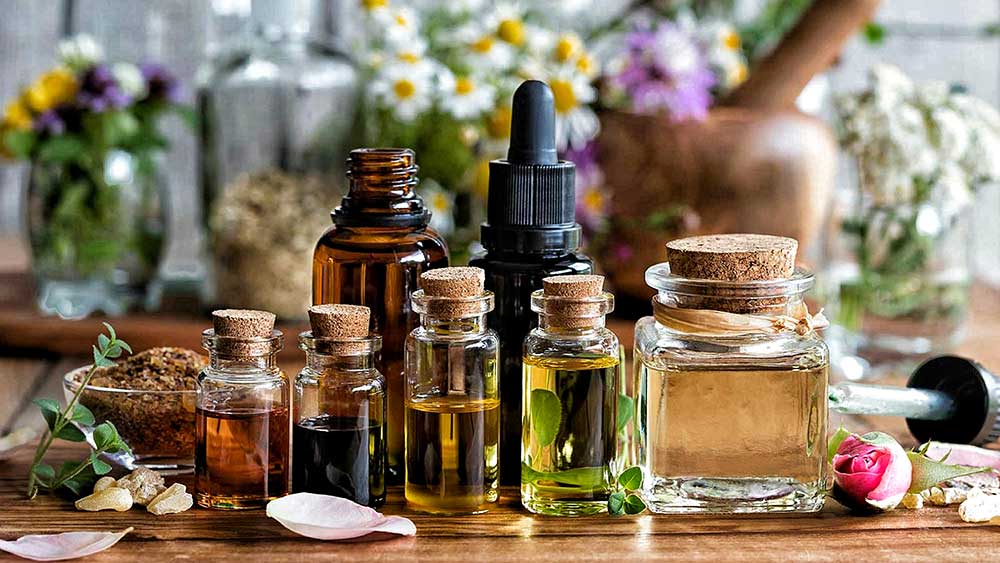
The following essential oils are most often used in DIY natural yoga mat sprays. The best part about making your own mix is you will get to know which oils will work best with you.
Your body may react to different oils differently. Some may even trigger adverse reactions in you, and some scents may not be appealing to you. So being able to mix your own yoga mat spray will give you more control over the process.
Melaleuca Tea Tree Essential Oil
The melaleuca tree is native to Queensland and New South Wales, Australia. It can be used topically for its antibacterial, antifungal, and antiviral properties. It also has inhibiting effects against influenza.
Oregano Essential Oil
Oregano oil has antimicrobial, antiviral, and antifungal properties. In addition, when diluted and taken internally, it is antiparasitic, anti-inflammatory, aids with digestive problems, and inhibits the growth of tumors.
Lavender Essential Oil
The scent of lavender helps you sleep faster and is used in many shampoos and cosmetic products. But this essential oil is also a disinfectant, antibacterial, and keeps pests away.
Lemon Essential Oil
Lemon is known as a great cleaner. This citrus fruit’s essential oil can be used on the body, on surfaces, dishes, clothes, and other things that have the potential for contamination. Its pleasant scent and antiseptic qualities make it an excellent ingredient for cleaning and cosmetics.
Peppermint and Eucalyptus Essential Oils
Both peppermint and eucalyptus have refreshing scents that make you feel fresh and relieve tension headaches. But they are also both known to have antifungal and antibacterial qualities, and they inhibit microbial activity even with tests with antibiotic-resistant strains of Staphylococcus aureus.
Cinnamon and Clove Essential Oils
Cinnamon and clove may be ingredients you might keep in your kitchen pantry, but they can also double as healing herbs. They have natural antimicrobial, antifungal, antiseptic, and antiviral properties.
Thyme and Rosemary Essential Oils
Thyme and rosemary are more ingredients which you would probably find in your pasta sauce. Their essential oils have been used as natural antibacterials since ancient times. They also help keep pests away and improve immunity in the body.
Geranium and Cedar Essential Oils
Geranium and cedar are also plants that have been used since ancient times to keep pests and disease away. These essential oils inhibit bacterial and microbial growth and can be used to decontaminate buildings.
Caution When Using Essential Oils
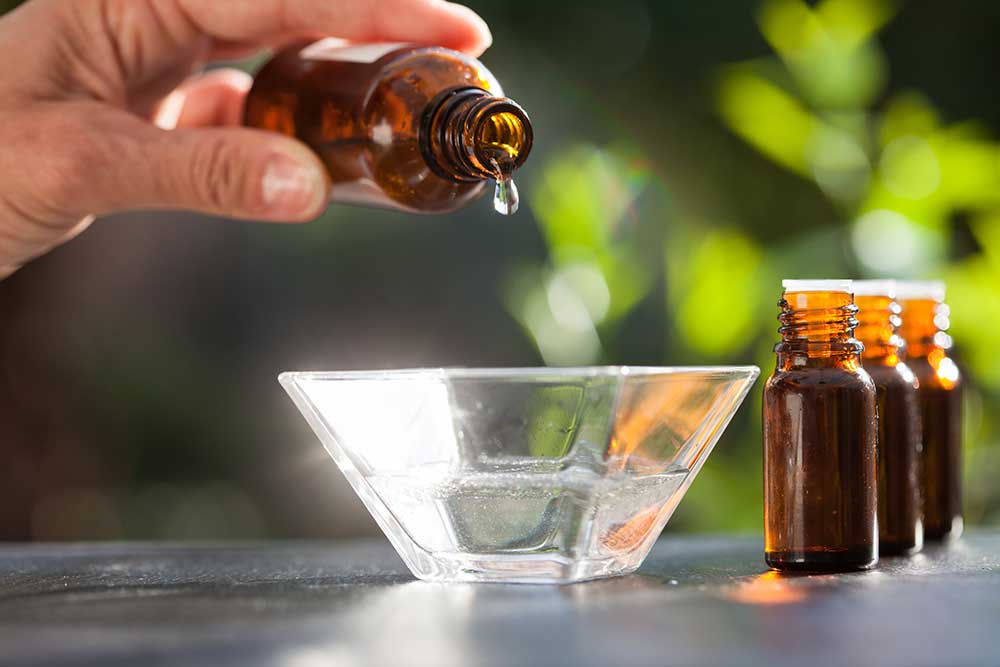
Essential oils are highly concentrated and extracted from fresh, preferably organically grown plants using a steam distillation process. Even though essential oils seem like little magic potions for health and cleaning, they should be used with caution.
Certain essential oils should not be used around children, pregnant people, or pets. They should also be diluted with water or a carrier oil and not put directly onto your skin.
It’s also best to choose essential oils that are organic and safe to ingest, even if you have no plans to eat or drink them.
Sprays and other products made with essential oils should be made in small batches. This is because essential oils lose effectiveness when exposed to air and sunlight. Keep your essential oils in their original amber or blue bottles away from the sun for as long as possible.
Easy Daily Yoga Mat Spray Recipe
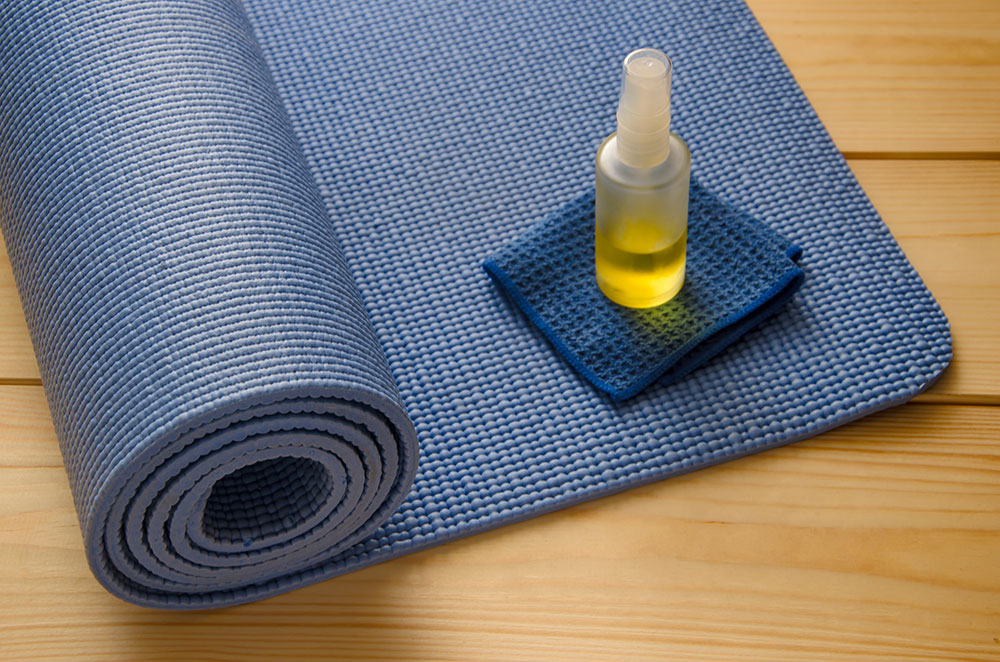
This is a basic recipe to make yoga mat spray that can be used with any combination of the essential oils mentioned above. Make sure to use high-grade, organic essential oils that are not mixed or diluted with other vegetable or other carrier oils.
Ingredients and Materials:
- 1 16 oz spray bottle
- 1/4 cup witch hazel
- 10 drops lavender essential oil
- 10 drops lemon essential oil
- 5 drops peppermint essential oil
- 3 drops tea tree essential oil
- Filtered water
Instructions:
Put the witch hazel and essential oils into the spray bottle. Add enough water to fill it to the top. Close the spray bottle and mix well.
Keep the bottle tightly closed and store it away from direct light.
Whenever you need to use the spray, mix it well and make sure you spray the entire surface of your yoga mat.
Wipe it down with a clean towel or allow it to air dry completely before rolling it back up.
Lemon Enzyme Recipe for Monthly Deep Cleaning
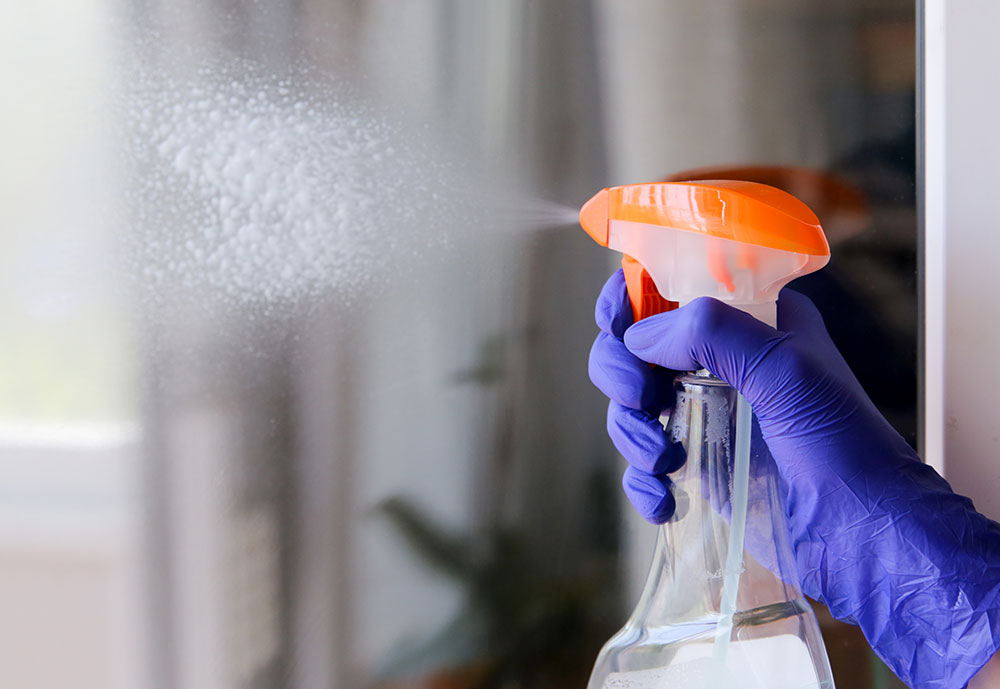
The recipe for DIY cleaning spray above is a good solution for daily use, but your yoga mat will still need a more thorough cleaning once in a while.
This lemon enzyme cleaner takes longer to make due to the fermenting time. But it’s an all-natural solution that will help give your mat a deeper cleaning once in a while.
The process is similar to making fruit wine. When the fermentation process is done, you’ll have an all-purpose cleaner that can be used to disinfect without harsh chemical products.
Another plus side to this recipe is that it uses scrap peels from any citrus fruit to go with a zero-waste lifestyle.
Ingredients and Materials:
- 2 liter bottle
- 300 g (or about 2 cups) lemon and/or orange peels
- 100 g (or about 1/2 cup) brown sugar
- 1 teaspoon yeast (optional)
- 1 liter filtered water
Instructions:
Use a funnel to pour all the brown sugar into the bottle. In India, jaggery is often used to make similar all-natural fruit enzyme cleaners.
Cut all the citrus peels into small pieces to fit easily into the lid of the bottle and place them all inside.
Pour the filtered water into the bottle. If you want to add yeast into the solution, add it in now.
Close the bottle and shake it rigorously to help distribute and dissolve the sugar granules.
Set the bottle aside and keep it slightly open to allow gasses to escape and shake it daily.
Allow it to ferment for two weeks if you added yeast. Ferment for three months if you did not add yeast (wild yeast, which is present in the air, will enter the solution and do the same job).
When the solution has fermented, use a strainer to remove the solid pieces and transfer the liquid into a clean bottle.
To use this lemon enzyme cleaner, dilute half a cup of it with one liter of water and use it to wash up your mat thoroughly. You can also use this same dilution as an all-purpose cleaner around your home.
This same cleaner can even be used to safely clean fruits and vegetables, sprayed directly on plants to keep pests away, and it is effective as a hair and facial cleanser too.
Additional Notes:
After you strain out the solid bits from this recipe, you can toss them into a blender with a few cups of baking soda until you get a desirable consistency for a cleaning scrub. Use this to deep clean sinks, bathrooms, floors, dirty pots and plates, and other surfaces.
In addition to lemon, orange, or other citrus peels, you can also use pineapple for this recipe to make an all-purpose enzymatic cleaner for your yoga mat.
Other Yoga Mat Care Reminders
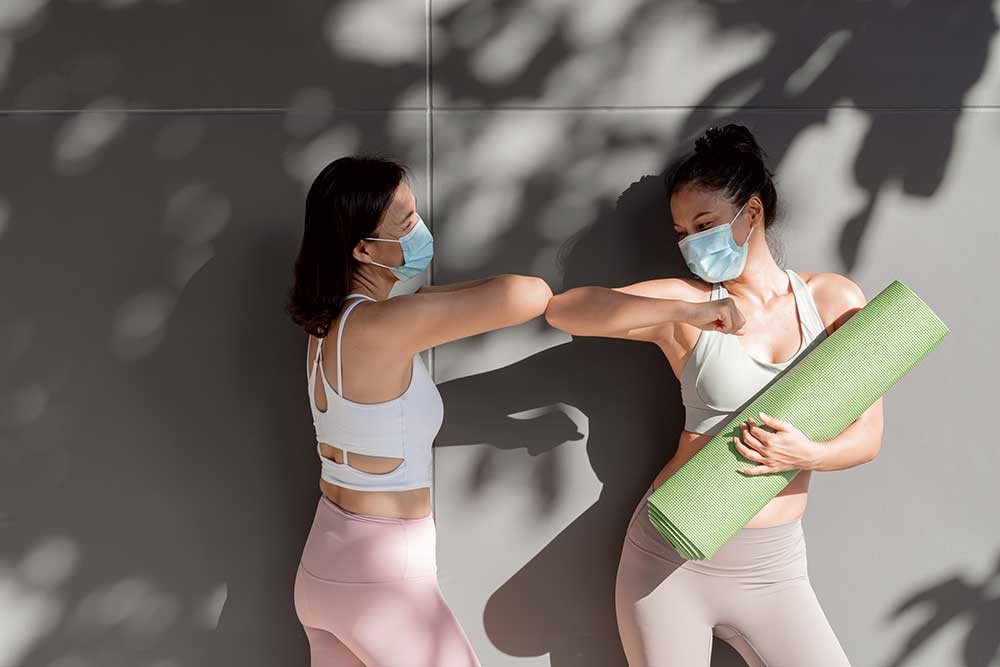
Use the essential oil yoga mat spray every time you use your mat before and after practice. And use the citrus enzyme cleaner at least once a month or more for a deeper and more thorough cleanse.
Here are other precautions you should take to ensure your yoga mat stays germ-free.
- Wash your hands and feet with soap and water for a minimum of 20 seconds before and after using your yoga mat.
- Maintain a distance of at least 6 feet or two meters away from others in your gym or yoga class if you are practicing in a group.
- Always ensure your mat is dry before rolling it up or storing it.
- Don’t touch the lid or lip of your water bottle with your hands while in class.
- Don’t go to a yoga class if you are sick.
Conclusion
In these times of uncertainty, going back to a regular yoga practice can help stay healthy and get back a sense of normalcy. But part of that is ensuring that you keep your yoga mat clean and safe from harboring germs and bacteria that can get you and others sick.
Making your own DIY natural yoga mat spray is not only economical, but a healthier way to keep your mat clean and clear of bacteria and germs. When used properly and with other hygienic tips in mind, you can continue to practice yoga with peace of mind.
What's Your Reaction?
Susan views the world through a lens of spirituality, health, and compassion. Her positive outlook on life shines through her writing, which is heavily focused on yogic living, meditation, and conscious eating.






